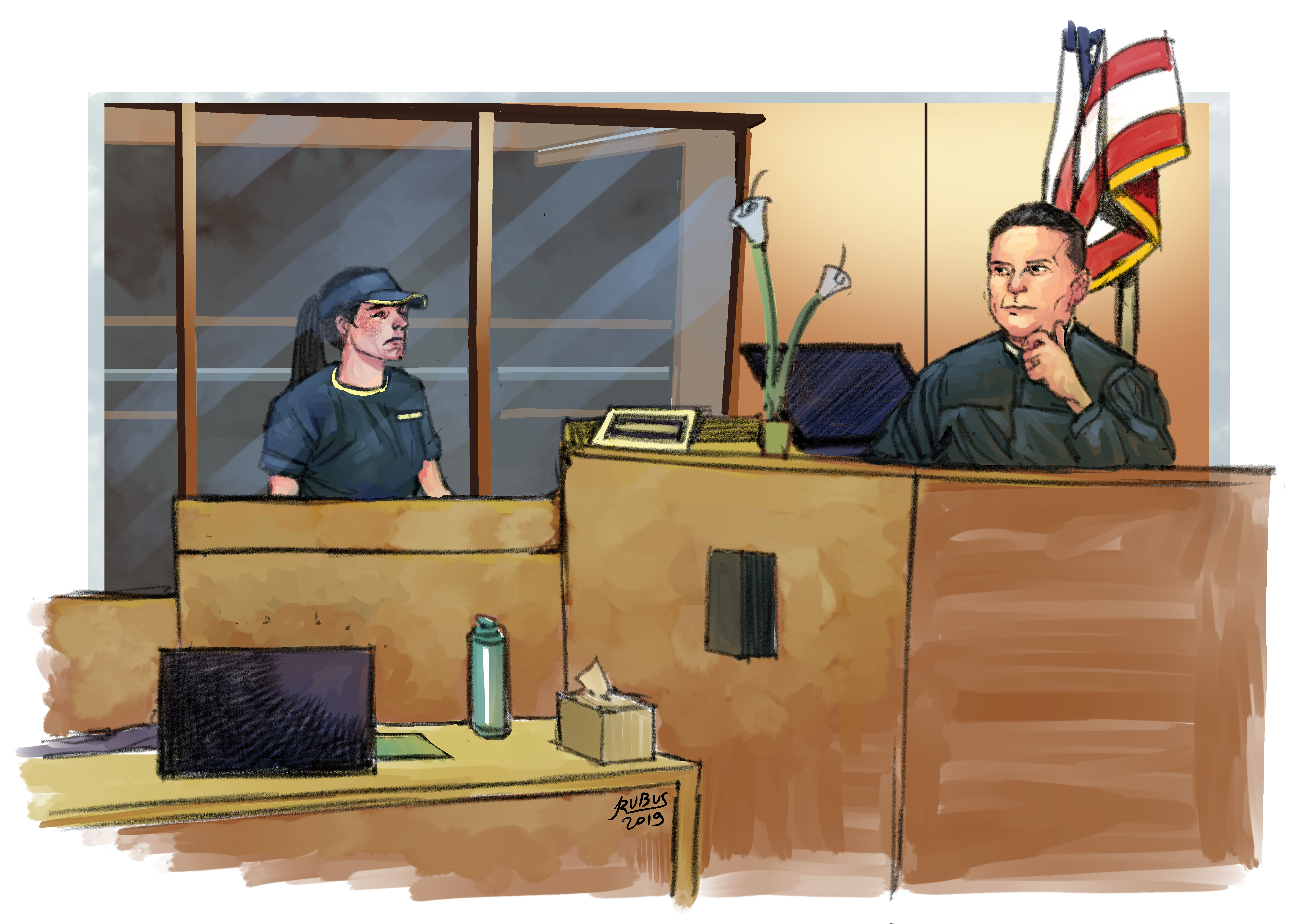Editor’s note: Out of respect for the privacy of one of the people depicted in this story, we have changed that person’s name.
In the fifth-floor hallway, a middle-aged white guy is speaking into his iPhone. Late 40s, ruddy, he looks like someone you’d stand behind in line for beer at a Dodgers game. “I mistakenly fucked up,” he confides, “so I’m sorry….” Mistake. Fuck up. Sorry. The mea culpas pile up like cars on a fog-shrouded Interstate 5.
Apologies are par for the course in the Criminal Courts Building. The Department 30 gallery is packed with mothers and sons, husbands and wives, brothers and sisters, all eager for information, explanations, closure. They’re lucky if they get a quick nod. “You may not communicate with defendants in custody,” a bailiff warns the public. “Waving ‘hi’ or blowing kisses… that’s considered communication.”
If only it were so easy.
Hrachya Azatyan, Arsen Grigoryan and Vahagn Mkhitaryan are herded into the in-custody enclosure and stand in uneasy proximity to one another. Each charged with a count of murder and attempted murder, the three Armenian speakers lean anxiously towards their defense attorneys, court-appointed Armenian language interpreters hovering nearby. The trio is in court today to postpone their arraignment by almost a month.
Two burly Armenians slip into the gallery and sit. Holding his iPhone up to eye level, one of the observers texts energetically. The bailiff approaches and warns him to put it away not once, but twice. The second time, the two men are commanded to leave. The texter blusters sotto voce that he wasn’t speaking on the phone, just messaging.The bailiff tells him there’s no difference and the men shuffle out, flustered.
No difference. In Department 30, as in most of the city’s courtrooms, everyday communication is officially curtailed, beginning with the physical separation of in-custodies and then exacerbated by the control of their exchanges with loved ones. Add to this the rarefied language of the law itself — in the hurly-burly of arraignment proceedings, statutes are referred to by their corresponding code numbers (e.g. 187, 1101(B)). Attorneys calls these “terms of art” — a specialized lingo meant to promote efficiency and facilitate communication. Every profession has its terms of art. But in criminal justice, they tend toward the exclusionary. To the uninitiated, attorneys can resemble a priesthood, their official exchanges part of some secret liturgy. “And counsel for each defendant join?” the judge inquires of the Armenians’ attorneys. They nod and concur. “Join on behalf of…”
In the Criminal Courts Building, outright expressions of regret, of stunned disorientation or doubt, are strongly discouraged. They must be communicated by other means. Recently, an in-custody in his twenties, beard scraggly, stood in the enclosure, hands folded over his belly as if in silent prayer. Facing extradition to Arizona, he scanned the gallery as if hoping to see a familiar face, or even make fleeting eye contact with a stranger. Asked by the judge if he waived his right to fight a return to Arizona, he shrugged and said no — while his body language suggested that Arizona was the very last place on earth he wanted to be. Resigned, he pulled his t-shirt collar up from beneath his county issues, wiped his face, and bowed his head.
Yet pathos abounds at 210 W. Temple Street. Yolanda Maria Quintanilla huddles into herself in the in-custody enclosure, her attorney and Spanish language interpreter close by. In contrast to almost all other in-custodies, Ms. Quintanilla doesn’t appear in county-issued scrubs, but wears a McDonald’s uniform. Charged in November 2018, she had been picked up on a warrant on her way to work that morning, charged with two counts of child endangerment dating back to April of that year. Deputy Public Defender Michael Enger explains that the defendant was charged with leaving her 3-year-old son in the care of an 11-year-old sibling. The older child had prepared some soup in a microwave and served it to her brother piping hot, scalding the younger child. Quintanilla “did not take the child … to receive medical care but tried to treat it herself,” Enger concedes. “There’s some allegation she did that for fear of the DCFS [Department of Child and Family Services] getting involved…”
Having only just been briefed by Quintanilla and her two sisters, watching from seats in the gallery, Enger pieces together his argument on the fly. “My understanding is that the child is completely healed and that this matter was subject to the jurisdiction of the Children’s Court up until July, and she was terminated from their jurisdiction. She’s a 20-year resident of Los Angeles, and she’s a 20-year employee of McDonald’s. You can see that she’s wearing her work uniform.”
Her McDonald’s uniform: not a prop but proof of Quintanilla’s occupation, an unmistakable visual cue in a setting that discourages any and all “tells,” from blown kisses to waves. And all the more powerful for its rarity.
As the uniform evidenced, the deputy public defender argues, Quintanilla was obliged to leave her children at home in order to go to work. He offers the court a solution: “With respect to any restraining order, she would abide by that. If she’s ordered to stay away from this child and all the other children, she can live with her sister, Maria Elena. She’s here in the courtroom, your Honor, and just raised her hand.”
Like her opposing counsel, Deputy District Attorney Lisa Kassabian also appears to be scrambling with Quintanilla’s sudden appearance in court. “This appears to be … Ms. Quintanilla appears to have five other filings or contacts with DCFS for her various children. She has five children.” The childcare situation, she avers, was untenable and to make matters worse, Quintanilla had not sought out medical care for her injured child, relying instead on home remedies. “Mother waited approximately eight days before she took her child to the hospital,” Kassabian informed the court. “And the self-care at home, the description of it, is very troubling. She was popping blisters and peeling his skin in an effort to try to administer self-care at home when he clearly needed to go to a hospital to be cared for.” The People conclude by asking that a protective order be issued, that bail remain at $100,000, and that the case be set for a preliminary hearing.
Taking into consideration the case’s extended timeline, the DCFS’s lack of involvement, and the absence of any indication of a criminal history, Judge Efrain M. Aceves releases the defendant on her own recognizance, simultaneously issuing a restraining order preventing her from seeing her children. Quintanilla absorbs Aceves’s decision. Freedom. Without her children. Suddenly shrunken within her polyester uniform, she shuffles out of the enclosure back into lock-up and eventual discharge.




